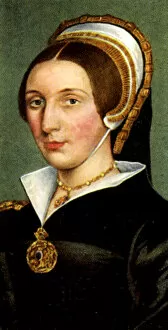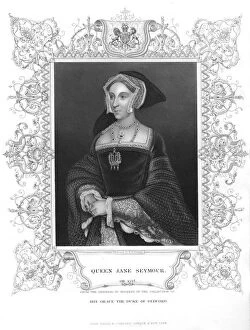Queen Consort Of England Collection (page 2)
"Unveiling the Enigmatic Queens
For sale as Licensed Images
Choose your image, Select your licence and Download the media
"Unveiling the Enigmatic Queens: A Glimpse into the Lives of England's Queen Consorts" Step back in time and immerse yourself in the captivating world of England's queen consorts. Through stunning portraits, we are transported to an era where power, politics, and love intertwined. In Holbein's masterful brushstrokes, Jane Seymour emerges as a vision of grace and poise. Her portrait from 1536 captures her ethereal beauty that bewitched King Henry VIII himself. As we gaze upon this timeless artwork, we can almost feel her presence radiating from the canvas. Catherine Howard's portrait from 1935 tells a different tale - one filled with youthfulness and innocence. Yet behind those innocent eyes lies a tragic story that ended too soon. This depiction serves as a reminder of the fleeting nature of happiness in Tudor times. Anne of Cleves appears twice within our collection - once in Hans Holbein's iconic painting from 1539 and again in an unknown artist's rendition from 1830. These contrasting images showcase Anne’s transformation from being rejected by Henry VIII to becoming a symbol of resilience and strength. Moving forward to Catherine Parr, we encounter another enigmatic figure captured beautifully by Holbein around 1530. Her intelligence shines through her eyes, hinting at her influential role not only as queen consort but also as regent during Henry VIII’s military campaigns. Henrietta Maria graces us with an enchanting engraving that exudes elegance and sophistication. As wife to Charles I during turbulent times, she navigated political turmoil while leaving behind an enduring legacy as a patroness of arts and culture. The Old Chelsea Manor House transports us to Henrietta Maria’s sanctuary –a place where she found solace amidst chaos—a testament to her resilience against adversity. Queen Jane Seymour takes center stage once more through H Robinson’s early-mid-19th-century portrait.


